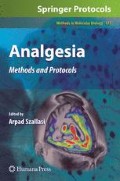Abstract
To facilitate the study of pain transmission and the characterization of novel analgesic compounds, an array of experimental animal pain models has been developed mainly in rodents. In these preclinical models, nociceptive pain can be measured by both spontaneous and evoked behaviors. Acute pain (seconds to hours) can be more easily measured, albeit still with some difficulty, by spontaneous behaviors (nocifensive behaviors such as licking, flinching), or by stimulation of the injured paw. Chronic pain (lasting at least several days) is most readily measured by evoked stimulation (thermal, mechanical, chemical). Experimental measures of evoked pain are well characterized and are analogous to clinical diagnostic methods. This chapter will focus on rodent models of inflammatory and nociceptive pain that are most used in our laboratory for identification of novel antinociceptive compounds in drug discovery.
Access this chapter
Tax calculation will be finalised at checkout
Purchases are for personal use only
References
Scholz J, Woolf CJ (2002) Can we conquer pain? Nat Neurosci 5 Suppl:1062-1067
Cervero F, Laird JM (1996) Mechanisms of touch-evoked pain (allodynia): a new model. Pain 68:13-23
Millan MJ (1999) The induction of pain: an integrative review. Prog Neurobiol 57:1-164
Coda B, Bonica J (2001). In: Bonica’s management of pain. Lippincott, Baltimore, pp 222-240
Byers M, Bonica J (2001). In: Bonica’s management of pain. Lippincott, Baltimore, pp 26-72
Meyer RA, Campbell JN, Raja SN (1985). In: Advances in pain research and therapy. Raven, New York, pp 55-71
Woolf CJ, Costigan M (1999) Transcriptional and posttranslational plasticity and the generation of inflammatory pain. Proc Natl Acad Sci U S A 96:7723-7730
Urban MO, Gebhart GF (1999) Supraspinal contributions to hyperalgesia. Proc Natl Acad Sci U S A 96:7687-7692
Woolf CJ (1983) Evidence for a central component of post-injury pain hypersensitivity. Nature 306:686-688
Woolf CJ, Thompson SW (1991) The induction and maintenance of central sensitization is dependent on N-methyl-D-aspartic acid receptor activation; implications for the treatment of post-injury pain hypersensitivity states. Pain 44:293-299
Woolf CJ, Salter MW (2000) Neuronal plasticity: increasing the gain in pain. Science 288:1765-1769
Watkins LR, Milligan ED, Maier SF (2001) Spinal cord glia: new players in pain. Pain 93:201-205
Tsuda M, Inoue K, Salter MW (2005) Neuropathic pain and spinal microglia: a big problem from molecules in “small” glia. Trends Neurosci 28:101-107
Hargreaves K, Dubner R, Brown F, Flores C, Joris J (1988) A new and sensitive method for measuring thermal nociception in cutaneous hyperalgesia. Pain 32:77-88
Ueda H (2006) Molecular mechanisms of neuropathic pain-phenotypic switch and initiation mechanisms. Pharmacol Ther 109:57-77
Fernihough J, Gentry C, Malcangio M, Fox A, Rediske J, Pellas T, Kidd B, Bevan S, Winter J (2004) Pain related behaviour in two models of osteoarthritis in the rat knee. Pain 112:83-93
Choi Y, Yoon YW, Na HS, Kim SH, Chung JM (1994) Behavioral signs of ongoing pain and cold allodynia in a rat model of neuropathic pain. Pain 59:369-376
Chaplan SR, Bach FW, Pogrel JW, Chung JM, Yaksh TL (1994) Quantitative assessment of tactile allodynia in the rat paw. J Neurosci Methods 53:55-63
Acknowledgments
Thank you to Gricelda Simler and Donna Gauvin for their insights into practical aspects in testing rodents in these models and to Elizabeth Cronin, Donna Gauvin, Heidi Shafford and La Geisha Lewis for clarification of methodological detail.
Author information
Authors and Affiliations
Corresponding author
Editor information
Editors and Affiliations
Rights and permissions
Copyright information
© 2010 Springer Science+Business Media, LLC
About this protocol
Cite this protocol
Boyce-Rustay, J.M., Honore, P., Jarvis, M.F. (2010). Animal Models of Acute and Chronic Inflammatory and Nociceptive Pain. In: Szallasi, A. (eds) Analgesia. Methods in Molecular Biology, vol 617. Humana Press, Totowa, NJ. https://doi.org/10.1007/978-1-60327-323-7_4
Download citation
DOI: https://doi.org/10.1007/978-1-60327-323-7_4
Published:
Publisher Name: Humana Press, Totowa, NJ
Print ISBN: 978-1-60327-322-0
Online ISBN: 978-1-60327-323-7
eBook Packages: Springer Protocols

